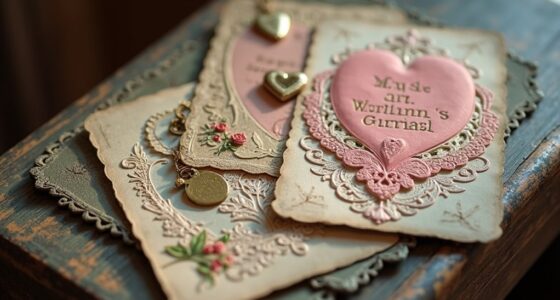Courtly love and Chaucer’s poetry greatly influenced Valentine’s Day by transforming love into a poetic and noble act. Chaucer’s stories and themes emphasized devotion, admiration, and symbolic gestures of affection that set the foundation for modern romantic traditions. His blend of courtly love ideals with storytelling helped elevate Valentine’s Day from simple celebration to an art of expressing deep reverence. Exploring these influences reveals how medieval poetry still shapes our ideas of love today.
Key Takeaways
- Chaucer incorporated courtly love themes into his poetry, shaping romantic ideals associated with Valentine’s Day.
- Medieval love poetry emphasized poetic language, allegory, and symbolism, influencing romantic customs celebrated today.
- Chaucer’s works elevated love to noble and moral pursuits, reinforcing Valentine’s Day as a celebration of devotion.
- Literary traditions from medieval romances established love as an aspirational and divine act, inspiring modern romantic gestures.
- The poetic and allegorical style of Chaucer’s writings helped embed love as an art form in Valentine’s Day celebrations.

Valentine’s Day, often associated with love and romance, owes much of its cultural significance to literary influences that have shaped how we celebrate. One of the most notable origins lies in the medieval romance genre, a form of storytelling that emphasized chivalry, courtship, and idealized love. These stories, rooted in poetic traditions, laid the groundwork for the romantic ideals we now associate with Valentine’s Day. As you explore its history, you’ll find that medieval romances elevated love beyond mere attraction, framing it as a noble pursuit filled with devotion and moral virtue. These tales, often composed in verse, celebrated the idea of courtly love—a secret, adoring affection that was both passionate and respectful, often expressed through poetic language.
Medieval romance stories, especially those from the 12th and 13th centuries, became the literary blueprint for the romantic ideals that persist today. Poets and writers used poetic traditions to craft elaborate narratives of love, idealizing the beloved and elevating the act of courtship to an art form. This poetic style, rich with allegory and metaphor, helped romantic love transcend everyday circumstances, transforming it into something divine and worth pursuing with devotion. You might notice how these poetic traditions emphasize the importance of gestures, words, and symbolic acts, which still appear in modern expressions of love, such as love letters or romantic gestures on Valentine’s Day.
Medieval love poetry elevated courtship into an art of allegory, shaping modern romantic gestures and Valentine’s Day traditions.
One of the most influential figures in this literary evolution was Geoffrey Chaucer, whose works further embedded these themes into popular culture. Chaucer’s “The Parlement of Foules” and “The Knight’s Tale” explore themes of love and chivalry, blending courtly love ideals with storytelling that appeals to a broad audience. He drew inspiration from the medieval romance tradition, embedding poetic devices and elaborate symbolism that reinforced the notion of love as a noble pursuit. Chaucer’s use of poetic traditions helped cement the idea that love should be celebrated with respect, admiration, and poetic expression—principles that continue to influence how we observe Valentine’s Day today.
Furthermore, these literary themes have persisted through centuries, shaping the romantic customs and symbols associated with the holiday. In essence, these literary influences—medieval romances and poetic traditions—shaped our understanding of love as something lofty and poetic. They elevated simple attraction into an art form, inspiring countless love stories and romantic customs. When you give or receive a Valentine’s card today, you’re participating in a tradition that echoes centuries of poetic storytelling and noble ideals, rooted in the medieval romance tradition that celebrated love’s enduring power through poetry and chivalry.
Frequently Asked Questions
How Did Courtly Love Influence Modern Romantic Traditions?
You can see how medieval courtship still influences modern romantic traditions through romantic symbolism, like giving flowers or writing love notes. These customs stem from courtly love, where knights and lovers expressed their devotion with poetic gestures and symbolic tokens. This history encourages you to celebrate love with meaningful acts that emphasize admiration and respect, shaping how we observe and cherish romantic relationships today.
Were Chaucer’s Works Widely Read During His Lifetime?
You might think Chaucer’s works were widely read during his lifetime, but historical evidence suggests his popularity was more limited, partly due to the limited dissemination of medieval manuscripts. While he was respected among court circles, the broader public probably didn’t access his writings frequently. Despite this, his influence grew considerably posthumously, shaping English literature and cultural traditions like Valentine’s Day, even if his immediate readership was relatively small.
What Symbols From Chaucer’s Era Are Still Used Today?
You see symbols from Chaucer’s era still used today, especially in medieval heraldry and love token symbolism. Heraldic crests and coats of arms, with their intricate designs, remain meaningful in family identities. Love tokens, like rings and tokens engraved with symbols, continue to represent affection. These symbols, rooted in Chaucer’s time, endure because they convey loyalty, identity, and love—timeless themes still relevant in modern celebrations and symbolism.
Did Medieval Love Poetry Differ Regionally Across Europe?
You’ll find that medieval love poetry did differ regionally across Europe, shaped by diverse cultural love customs and local poetic styles. In some regions, poetry emphasized chivalry and noble love, while others focused on courtship rituals or religious devotion. These regional poetic styles reflect how different cultures expressed love, making each area’s love poetry unique and deeply connected to their societal values and traditions.
How Did Religious Beliefs Shape Courtly Love Practices?
Religious beliefs deeply shaped courtly love practices by embedding medieval morality and religious symbolism into the tradition. You’d see love often portrayed as a spiritual journey, emphasizing purity, devotion, and moral virtue. This influence encouraged nobles and poets to frame love as a higher, almost sacred pursuit, aligning romantic ideals with Christian values, and reinforcing the idea that true love involved moral integrity and reverence, not just physical desire.
Conclusion
So, next time you celebrate Valentine’s Day, remember it’s more than just chocolates and roses—it’s a centuries-old tradition shaped by the dazzling worlds of courtly love and Chaucer’s timeless poetry. Their influence is so powerful, it’s like Cupid himself whispered these customs into history’s ear. By understanding these literary roots, you’ll see your romantic gestures in a whole new light, making your love story feel as epic as the tales that started it all.







